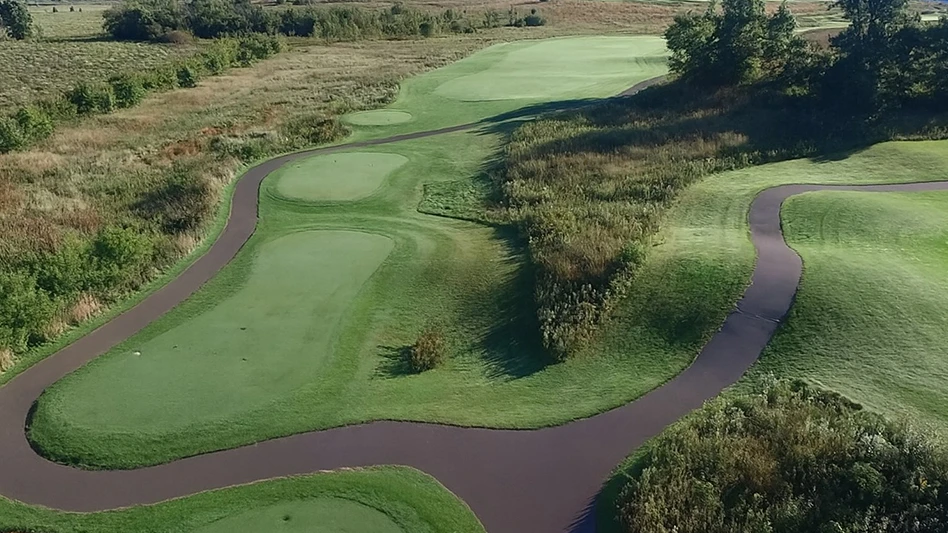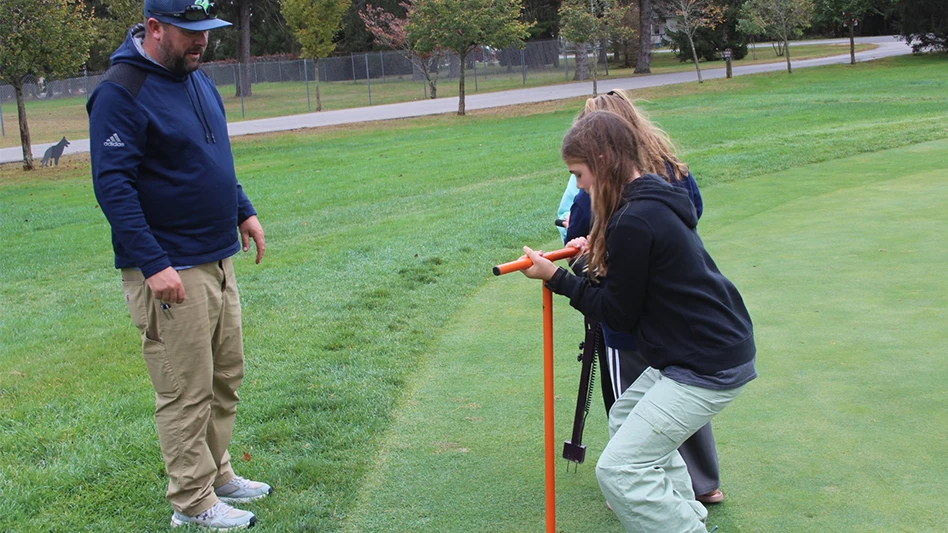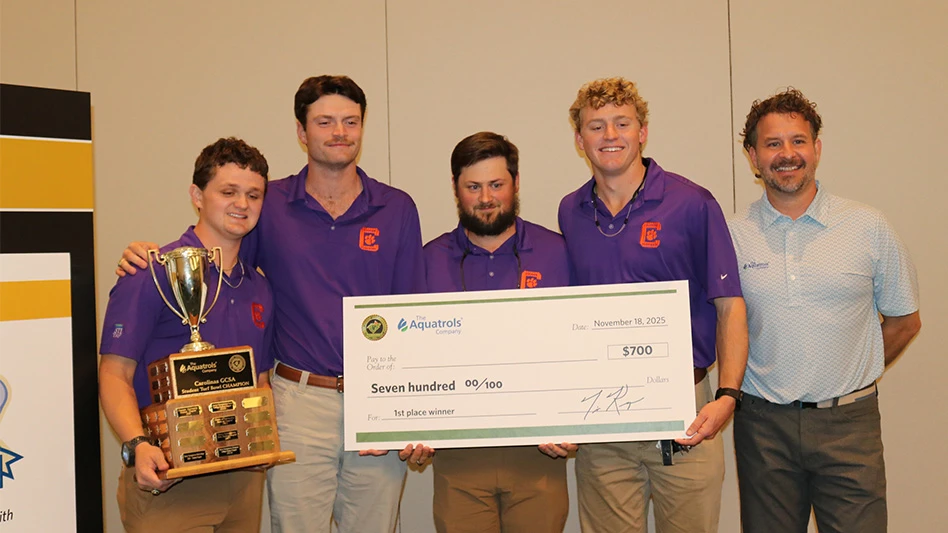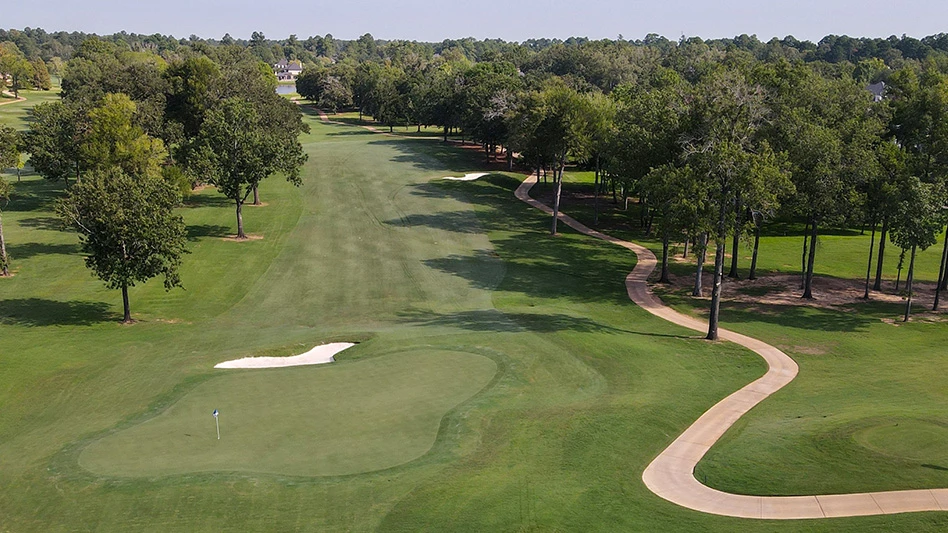Think back to when you were a kid: The summer sun was sweltering down, sweat dripped from the end of your nose and all you craved besides a Popsicle was a misting of water to cool you down. Plants, just like humans, sometimes need a good cooling. When your turf’s canopy gets too hot, a wee bit of water is sometimes all it needs.
We’re talking about syringing – the technique superintendents use to add moisture to their greens and to cool the turf down and prevent dry wilt that leads to loss of turf if not controlled. It’s also done to keep greens uniform.
Syringing is most often done when greens are under stress from high heat and windy conditions. The plant starts to wilt and some light watering is necessary. The key word is light. Most in the profession agree that hand watering is not syringing. That said, not all keepers of the green agree on a universal definition for syringing.
Creating uniformity
For Andy Short, superintendent at Cherry Blossom Golf Club in Georgetown, Ky., the ultimate goal of syringing is uniformity. He says every green should react the same in regard to how an approach shot releases and how the ball rolls from a putt.
“A major factor in how that ball reacts is moisture level,” Short explains. “The expectation level of the club or board will determine what’s the acceptable amount of moisture to apply to the greens. Some clubs prefer ‘firm and fast,’ while others are happier being able to control and hold their shots into the green.”
Cherry Blossom is a semiprivate club with most traffic coming from public players; Short says it’s important that the greens are at a “comfortable” level so that players of all abilities can enjoy their round and move through the course in a reasonable time frame. After establishing what the acceptable level of moisture is, Short uses a combination of sight and feel to determine when and how much water to put down.
“For those of us who don’t have moisture sensors, visual cues are the first clues to areas that may need more water,” he explains. “Whether it’s actually seeing the plant change color, or seeing your footprints, wilt is the first sign that the plant needs water. The severity of wilt and environmental conditions will determine how much water is put down. I use a soil probe to see/feel how deep and how much moisture is in the soil. I remove the soil from the probe and place it in my hand and make a fist. If the soil clumps and stays together I don’t apply any water to that area. Conversely, if the particles don’t bind together and fall apart, that area is in need of water.”
Another – quicker – method Short uses to check moisture is with a knife. “I will go to different areas of the green and punch my knife into the soil and if the blade has soil particles stuck to it, there’s moisture in the soil.”
Determining frequency
Short says determining how often to syringe greens is based on weather conditions and how the turf reacts to them.
“Temperature, wind, humidity, type of turfgrass, soil type and thatch levels all play an important role in the level of moisture available to the plant,” he says. “All must be considered when deciding whether or not to syringe and how much water to put down.
“Each green is checked because not every green is exposed to the same conditions or has the same contours,” he adds. “Trees that are next to greens become a huge variable when it comes to syringing. Trees can block sunlight and air movement, restricting evapotranspiration levels. Depending on the size of the tree and its proximity to the green, the root structure of the tree also can rob the green of water and other essential nutrients.”
Short and his assistant do all of the syringing at Cherry Blossom.
“I feel syringing greens is one of the most critical jobs done on a golf course and shouldn’t be left to untrained hands,” he says. “My staff is relatively limited and I would rather be in control of how much water is going down on the greens. I firmly believe that whoever is syringing must truly care about what they are doing and understand why they are doing it, as opposed to just doing a job.”
Short typically tackles hot spots with hoses rather than the irrigation system or specialty equipment.
“The only time I’ll use the irrigation system to syringe is if I have more than one fire to put out,” he says. “I’ll throw up the heads for just a minute or two to cool of the surface and hopefully keep things in tact until I can get to it.”
A systematic way
Kevin Hutchins, superintendent at Mission Viejo Country Club in Mission Viejo, Calif., developed the MobileMist to a have a systematic way to measure temperature canopy on greens and an efficient, repeatable way to cool the temperature canopy of the greens.
“I found in the past that each employee monitored the greens in their own way and many times they would turn on the sprinklers or use a hose for too long a period of time when syringing the greens,” he explains. “Many times the staff were actually irrigating the greens instead of syringing.”
Hutchins was also looking for ways to conserve water.
“When you run the sprinklers for three minutes to syringe the greens you use 5,700 gallons of water each day,” Hutchins says. “Over a 90-day summer, that is more than 500,000 gallons of water to try to cool the greens. With the MobileMist, on a really hot day, you use just 50 gallons of water, which is only 4,500 gallons over the entire summer.”
The MobileMist comes with a laser temperature gun and a log book. Hutchins says each day a staff member shoots the green with the laser and records the temperature in the log. He uses 94 degrees as his trigger to start using the MobileMist to cool the greens.
What he loves about the system is that it’s very repeatable and anyone can do it.
“If the temperature is above 94 degrees the staff member runs the MobileMist around the green in about two minutes,” Hutchins explains about the system. “The temperature is measured again and recorded in the book. The average temperature drop is about seven to 10 degrees depending on the wind and the humidity. I start on hole No. 18 and go backwards until all the greens are checked and cooled as needed.
“I then go back to 18 and recheck the greens. If the temperature is above 94, I mist them again,” he adds. “If 18, 17 and 16 greens are below 94 degrees, the employee can pack up and go home for the day. It is a repeatable system with little room for error.” GCI
David McPherson is a freelance writer based in Toronto.

Explore the March 2010 Issue
Check out more from this issue and find your next story to read.
Latest from Golf Course Industry
- From the publisher’s pen: Conscientious of a bigger role
- Bernhard and Company partners with Laguna Golf Phuket
- Terre Blanche showcases environmental stewardship
- VIDEO: Introducing our December issue
- Bernhard and Company introduces Soil Scout
- Nu-Pipe donates to GCSAA Foundation’s Centennial Campaign
- GCSAA enhances golf course BMP tool
- Melrose leadership programs sending 18 to 2026 GCSAA Conference and Trade Show





